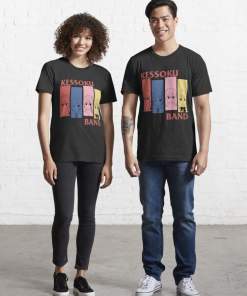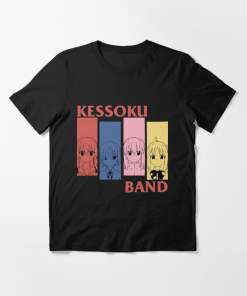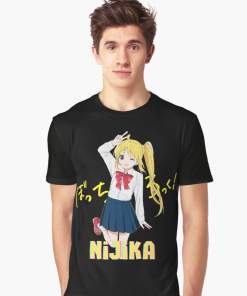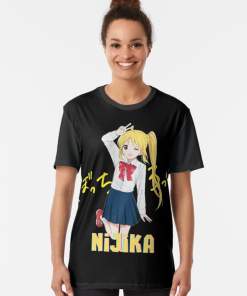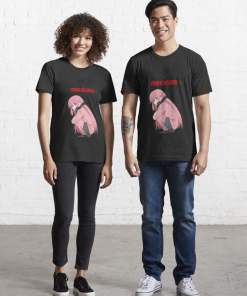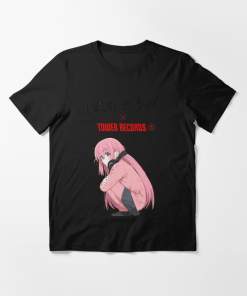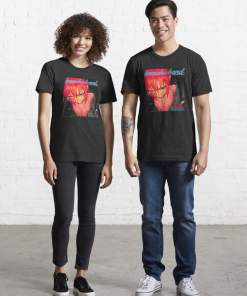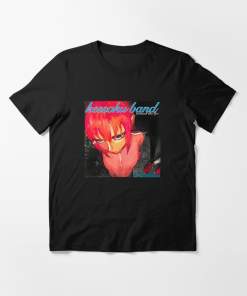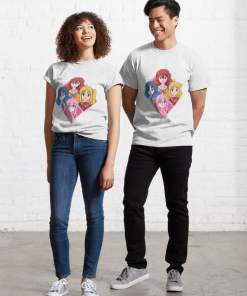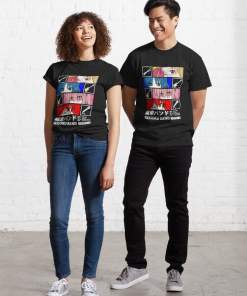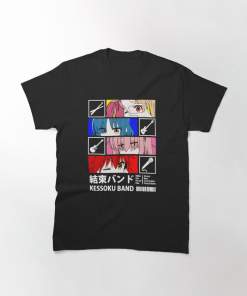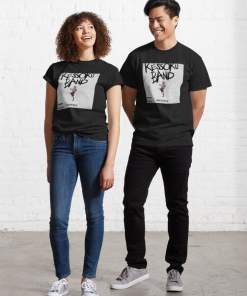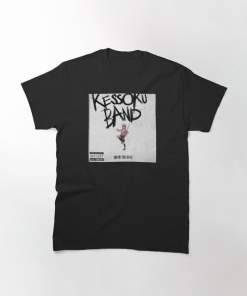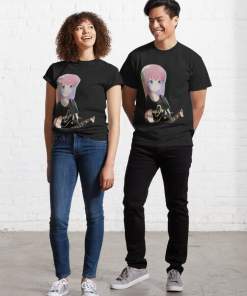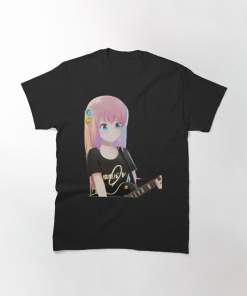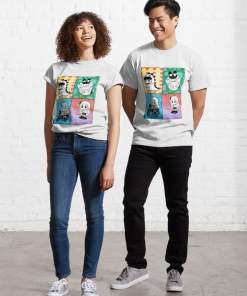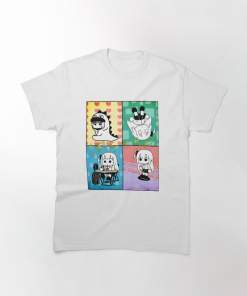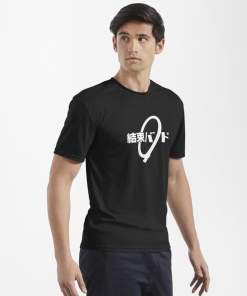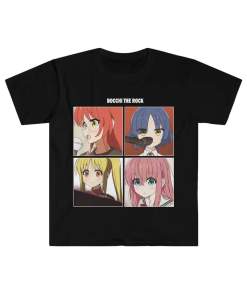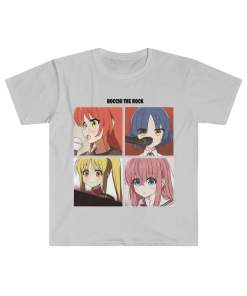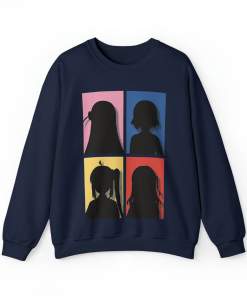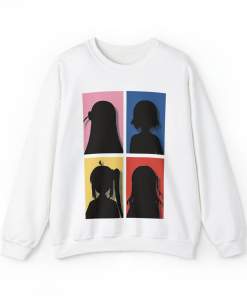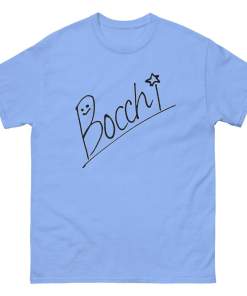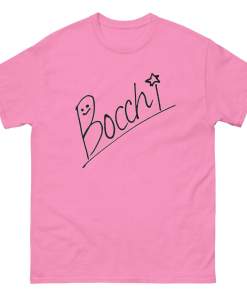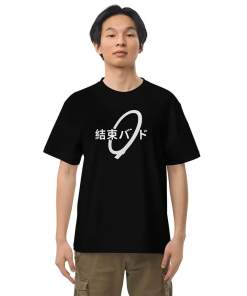Discover the Essence of Fashion – Explore Kessoku Band Shirt Collection at Vilo Trend. Kessoku Band Shirt at Vilo Trend ✓ Iconic designs ✓ Extensive variety ✓ Hassle-free 30-day returns ✓ Dive into the world of Kessoku Band Shirt now! Uncover premium Halloween T-Shirts, uniquely crafted and offered by independent artists, exclusively on Vilo Trend. Experience a spectrum of colors and styles tailored
⏩ You may also love: Marvel Periodic Table Shirt
Kessoku Band Shirt
Definition of a Kessoku Band Shirt
In the kaleidoscopic realm where music and fashion converge, a distinctive and emblematic phenomenon has taken shape – the Kessoku Band Shirt. These garments transcend mere articles of clothing; they embody an entire culture, weaving together the vibrant threads of music, identity, and style. To embark on an exploration of Kessoku Band Shirts is to venture into a domain where fabric becomes canvas, and the human form becomes a canvas for sonic and visual artistry. To comprehend the essence of Kessoku Band Shirts, we must first establish a fundamental understanding of what precisely constitutes this enigmatic apparel.
A Kessoku Band Shirt, often simply referred to as a "band tee," is no ordinary piece of clothing. It is, at its core, a tangible manifestation of the profound connection between music and its most fervent admirers. These shirts bear the insignia, imagery, or emblematic symbols of a specific musical group or artist. They serve as wearable expressions of musical allegiances, allowing wearers to signal their affiliation with a particular genre, subculture, or musical narrative.
Intriguingly, Kessoku Band Shirts are characterized by their diverse range of designs and aesthetics, acting as canvases that encapsulate the spirit of the music they represent. From intricate album artwork to minimalist typography, from psychedelic landscapes to punk-inspired graphics, the visual language of these shirts is as diverse as the musical landscape itself. Each Kessoku Band Shirt tells a unique story, and through its design, it invites wearers to become active participants in that narrative.
As we delve deeper into the multifaceted world of Kessoku Band Shirts, we shall discover that these garments are more than just attire; they are an embodiment of artistic synergy, cultural identity, and personal expression. This exploration will unveil the profound significance of Kessoku Band Shirts within the music community, illuminating their role as tangible conduits through which fans connect with the sounds, stories, and sensations that resonate deeply within their hearts.
Significance of Kessoku Band Shirts in the world of music and fashion
In the ever-evolving intersection of music and fashion, few phenomena encapsulate the potent fusion of these two expressive realms quite like the Kessoku Band Shirt. These garments transcend their status as mere articles of clothing to become vibrant canvases that embody the very spirit of both musical and sartorial innovation. Within this dynamic synergy, Kessoku Band Shirts emerge as cultural artifacts of profound significance, simultaneously bridging the gap between auditory and visual artistry while forging a tangible connection between musicians and their ardent devotees.
The Kessoku Band Shirt, often regarded simply as a "band tee," emerges as an icon of individual and collective identity within the vast expanse of the music and fashion landscape. It stands as a testament to the enduring resonance of music as a universal language and fashion as a means of self-expression. To truly appreciate the significance of these shirts is to embark on a journey through a cultural tapestry where sound and style interweave, creating a narrative that is at once deeply personal and universally resonant.
At its core, the Kessoku Band Shirt serves as a symbolic bridge between the auditory and the visual. It bears the visual representation of a specific musical entity, whether a legendary band, an emerging artist, or an iconic album cover. This visual insignia, emblazoned upon the fabric, becomes a badge of honor, allowing individuals to proudly declare their allegiance to a particular musical genre, era, or ethos. In doing so, these shirts become more than just fashion statements; they evolve into artifacts that chronicle the ever-shifting tides of music history.
Beyond their role as identity markers, Kessoku Band Shirts play a pivotal role in the symbiotic relationship between musicians and their fanbase. They become ambassadors of music, disseminating the sonic aesthetics of a particular artist or band to a wider audience. They serve as souvenirs of memorable concerts, acting as tangible links to the raw energy and emotion experienced during live performances. In essence, Kessoku Band Shirts are emblematic of a shared journey, a visual representation of the profound connection between creators and their admirers.
As we embark on a deeper exploration of the significance of Kessoku Band Shirts, we unveil their profound influence not only in the world of music but also in the realm of fashion. These shirts have transcended the boundaries of subcultural attire to become mainstream fashion staples, infiltrating the wardrobes of music enthusiasts and fashion-forward individuals alike. This intersection of music and fashion, as exemplified by Kessoku Band Shirts, is a testament to the enduring power of art to inspire, unite, and transform. In this intricate dance between melody and fabric, we uncover a narrative that is rich, multifaceted, and profoundly resonant.
Thesis statement: Kessoku Band Shirts are more than just clothing; they are a symbol of identity and culture within the music community.
Within the intricate tapestry of music and fashion, the Kessoku Band Shirt stands as a remarkable emblem of transcendent significance. Beyond its material existence, it assumes the role of a powerful symbol, one that transcends the boundaries of mere clothing and emerges as a profound representation of identity and culture within the music community. The Kessoku Band Shirt is not merely fabric and ink; it is a canvas upon which stories, affiliations, and sonic landscapes are painted. In the following discourse, we shall navigate the multifaceted dimensions of Kessoku Band Shirts, unveiling their true essence as more than just clothing. Rather, they are, in their very essence, symbolic artifacts that encapsulate the rich tapestry of musical culture and individual identity, affirming their irreplaceable place in the collective heart of the music world.
Origins of band merchandise
The origins of band merchandise trace back to a pivotal juncture in music history when artists and their supporters began to recognize the potential of extending their creative reach beyond the confines of the recording studio and concert stage. The seeds of this novel concept can be found in the mid-20th century, as the music industry underwent transformative changes, both culturally and technologically.
One of the earliest instances of band merchandise can be attributed to the emergence of rock 'n' roll in the 1950s. As this genre gained momentum, pioneering artists like Elvis Presley and Buddy Holly recognized the opportunity to connect with their fans in a more tangible way. They started by offering a limited array of products such as posters, buttons, and T-shirts, often featuring their own likenesses or iconic album covers. These initial forays into merchandise were relatively modest in scope but laid the groundwork for a phenomenon that would eventually reshape the music industry.
The 1960s witnessed a seismic shift in both music and counterculture. Bands like The Beatles and The Rolling Stones, along with the burgeoning psychedelic movement, began to experiment with more elaborate and artistically expressive merchandise. The iconic "Sgt. Pepper's Lonely Hearts Club Band" album cover, for instance, became a vibrant emblem on a range of products, from shirts to posters, symbolizing the album's cultural impact.
However, it was the 1970s that witnessed the true proliferation of band merchandise, thanks in no small part to the rise of stadium rock and the globalization of music. Legendary acts like Led Zeppelin, Pink Floyd, and The Who recognized that merchandise could not only generate additional revenue but also serve as a means of forging deeper connections with their fanbase. Concert T-shirts, in particular, emerged as the quintessential item, a wearable badge of honor for those who attended monumental shows.
The advent of punk and punk rock in the late 1970s and early 1980s brought a DIY ethos to band merchandise. Bands like the Sex Pistols and The Ramones embraced a raw, anti-establishment aesthetic, often designing their own T-shirts and selling them at concerts. This era marked a departure from the polished mainstream and a return to the grassroots, with merchandise as a conduit for self-expression and subversion.
The digital age of the late 20th century and the 21st century witnessed a radical transformation in the production and distribution of band merchandise. Online platforms and e-commerce opened new avenues for artists to reach global audiences. Today, band merchandise has evolved far beyond the simple T-shirt, encompassing a vast array of products from limited-edition vinyl records to exclusive collectibles, connecting fans with their favorite artists in unprecedented ways.
In tracing this historical evolution, it becomes evident that band merchandise has journeyed from modest beginnings to become a thriving industry, embodying not only the artistic spirit of musicians but also the enduring connection between music, identity, and culture. The humble origins of band merchandise have grown into a complex and dynamic ecosystem, making it an integral part of the music experience and a testament to the profound impact of music on our lives.
Transition from simple merchandise to Kessoku Band Shirts
As the music industry continued to evolve, so did the realm of band merchandise. The transition from simple, straightforward merchandise to the intricate world of Kessoku Band Shirts represents a notable evolution in the way musicians and their fans engage with each other and the broader cultural landscape.
The early history of band merchandise was marked by relatively uncomplicated offerings, often consisting of basic items like buttons, posters, and modest apparel adorned with straightforward logos or album artwork. These products served as souvenirs for fans, allowing them to take a piece of the live music experience home with them. While these early items held sentimental value, they were, in essence, functional reminders of the concert or the album, lacking the deeper layers of meaning and identity that would come to define Kessoku Band Shirts.
The transformation towards Kessoku Band Shirts can be attributed to several factors, each contributing to the evolution of band merchandise. Firstly, as music genres diversified and subcultures emerged, fans sought to express their affiliation with specific musical movements in more nuanced ways. A T-shirt with a band's logo or album cover no longer sufficed; fans wanted garments that could capture the ethos and aesthetic of their favorite artists.
Secondly, the visual aspect of music became increasingly important. Iconic album covers, intricate stage designs, and artistic music videos played a central role in shaping the overall experience of music. Musicians and their fans recognized the power of these visual elements and sought to incorporate them into their personal identity. Kessoku Band Shirts emerged as a medium to encapsulate this visual language, allowing fans to carry a piece of the music's artistry with them wherever they went.
Another pivotal factor in this transition was the deepening connection between musicians and their audiences. In an era of social media and increased accessibility, fans craved more intimate and authentic interactions with their musical idols. Kessoku Band Shirts provided a means for artists to offer fans a tangible extension of their creative vision, fostering a sense of community and shared identity.
Furthermore, the shift toward Kessoku Band Shirts reflects the broader fusion of music and fashion. As music culture and streetwear converged, these shirts became not just symbols of musical allegiance but also fashion statements. Fans began to wear them not only to concerts but also as everyday attire, blurring the lines between music and fashion subcultures.
In essence, the transition from simple merchandise to Kessoku Band Shirts embodies the evolution of music culture itself. These shirts are no longer mere memorabilia; they are wearable canvases that encapsulate the spirit of the music they represent. They serve as dynamic symbols of identity, culture, and artistry within the music community, offering a glimpse into the ever-changing relationship between musicians, fans, and the broader world of creativity.
The role of Kessoku Band Shirts in representing music genres and subcultures
In the tapestry of music culture, Kessoku Band Shirts have emerged as more than mere garments; they are visual orchestrations that convey a profound sense of identity, belonging, and artistic affiliation. Central to their evolution has been their pivotal role in representing the diverse array of music genres and subcultures that have woven the rich fabric of the music industry.
Music, as a creative force, has always been deeply tied to the formation of distinct genres and subcultures. From the birth of jazz in the smoky clubs of New Orleans to the punk rock rebellion that sprouted in the underground scenes of the 1970s, each musical movement brought with it a unique ethos, sound, and visual aesthetic. Kessoku Band Shirts have, over time, become the iconic standard-bearers of these musical worlds.
These shirts serve as a visual lexicon, encapsulating the sonic landscapes and cultural nuances of specific music genres. For example, a Kessoku Band Shirt adorned with psychedelic artwork and vibrant colors immediately transports the observer to the mind-expanding sounds of the 1960s counterculture and the psychedelic rock era. On the other hand, a shirt featuring stark, minimalist design and monochromatic tones might evoke the rebellious spirit of punk and its raw, do-it-yourself ethos.
Moreover, Kessoku Band Shirts often bear the imprints of iconic album covers, lyrics, or insignias associated with a particular band or artist. This not only pays homage to the music but also acts as a visual anchor, connecting fans to the broader cultural context from which the music emerged. The shirt, in this context, becomes a portal to a specific time and place in music history.
Subcultures within the music world find a powerful ally in Kessoku Band Shirts. These shirts function as flags of affiliation, allowing members of various subcultures to proudly display their musical allegiances. Whether it's the leather-clad fans of heavy metal, the tie-dye enthusiasts of jam bands, or the vintage-loving devotees of indie rock, Kessoku Band Shirts become the uniform of choice for expressing membership in these distinct tribes. They not only signify an appreciation for the music but also an alignment with the values, aesthetics, and countercultural ethos associated with each subculture.
In essence, Kessoku Band Shirts are living embodiments of the intricate web of musical genres and subcultures that shape the sonic and cultural landscape. They are symbols of continuity in an ever-changing industry, offering fans a tangible connection to the music they adore and the communities they belong to. In this role, they transcend mere fashion and become vital agents in the perpetuation of music's diverse narratives and subcultural identities.
Variety in shirt designs
The world of Kessoku Band Shirts is a veritable kaleidoscope of visual artistry and creative expression. One of the defining characteristics that sets these shirts apart is the remarkable variety in their designs. These garments are not constrained by a singular aesthetic; instead, they serve as canvases that encapsulate the boundless creativity of musicians, graphic designers, and fans alike.
The range of Kessoku Band Shirt designs is staggering in its diversity. It spans from the boldly intricate to the elegantly minimalistic, from the vibrantly colorful to the starkly monochromatic. Each shirt is a visual representation of the music it represents, and as such, it is imbued with the ethos and aesthetic of the respective artist or band.
At one end of the spectrum, we find Kessoku Band Shirts that mirror the complexity and intricacy of the music they embody. These shirts may feature elaborate, multilayered designs that pay homage to the album art or themes of a particular release. They utilize intricate illustrations, detailed typography, and a myriad of colors to create a visual feast that mirrors the sonic complexity of progressive rock or the psychedelic reveries of certain genres. These shirts are, in essence, wearable works of art that invite fans to delve deep into the music's world.
Conversely, the minimalist approach is equally embraced within the world of Kessoku Band Shirts. Some designs strip away the excess, relying on a clean, understated aesthetic. These shirts often feature simple typography, iconic logos, or a single striking image, rendering them instantly recognizable and timeless. This minimalist approach echoes the raw energy and DIY ethos of punk and indie rock, where simplicity and authenticity are prized.
In addition to aesthetics, Kessoku Band Shirt designs often draw inspiration from the broader visual culture. They may incorporate elements of pop art, surrealism, or graphic design trends, offering a contemporary twist to traditional band merchandise. These eclectic influences ensure that Kessoku Band Shirts remain in conversation with the broader artistic landscape.
Furthermore, the designs of these shirts are not static but evolve alongside the music and its cultural context. New releases, anniversaries, and significant moments in a band's career often inspire fresh designs that capture the evolving spirit of the music. This fluidity ensures that Kessoku Band Shirts remain relevant and reflective of the ever-changing nature of music and its impact on culture.
In conclusion, the variety in shirt designs within the realm of Kessoku Band Shirts is a testament to the dynamic and multifaceted nature of music and its visual representation. These designs are more than just clothing; they are snapshots of the artistic and cultural landscapes, weaving together threads of music, fashion, and creative expression into a tapestry of boundless possibilities.
Use of imagery, symbols, and typography
Kessoku Band Shirts are a visual symphony, where every element – imagery, symbols, and typography – harmonizes to create a rich and multi-layered narrative. These shirts serve as canvases upon which the artistic essence of music is transmuted into tangible forms, inviting wearers to embark on a visual journey that parallels the sonic experience.
Imagery: One of the most captivating aspects of Kessoku Band Shirts is the use of imagery. Album artwork, iconic photographs, and original illustrations find their place on these shirts, becoming potent conduits for the visual interpretation of the music. The imagery can be deeply evocative, ranging from surreal dreamscapes to stark, gritty realism. Whether it's the ethereal landscapes that accompany progressive rock or the stark, rebellious imagery of punk rock, these visual representations become an integral part of the music's storytelling. They allow fans to carry with them a piece of the album's essence, offering a glimpse into the emotional landscapes that the music explores.
Symbols: Symbols are a universal language, and Kessoku Band Shirts are fluent in this dialect. Bands often incorporate symbols that are laden with meaning, either derived from their lyrics, album themes, or broader cultural iconography. These symbols serve as totems, carrying with them the collective consciousness of the music's message. From the peace signs of the 1960s counterculture to the anarchic symbols of punk, these visual cues provide a shorthand for fans to identify with and communicate their affiliations. They are badges of honor that transcend language and connect fans across boundaries.
Typography: Typography is the silent storyteller on Kessoku Band Shirts. The choice of fonts, lettering styles, and text placement is a meticulous craft. Typography can convey mood – from elegant and ornate script fonts that evoke a sense of grandeur to bold, blocky letters that shout rebellion. Song lyrics, album titles, or band names are often rendered with care, becoming both a visual and textual representation of the music. Typography also has a transformative power; a simple font change can completely alter the perception of a design, making it timeless or contemporary, classical or avant-garde.
In essence, the use of imagery, symbols, and typography in Kessoku Band Shirts is a masterful blend of artistic expression and storytelling. These elements are not random; they are carefully curated to reflect the essence of the music and the cultural context from which it emerges. Kessoku Band Shirts are, therefore, not just garments but dynamic visual narratives that invite wearers to immerse themselves in the music's world, providing a sensory and intellectual connection that transcends the boundaries of sound and vision.
Influence of album artwork and branding on shirt design
Within the realm of Kessoku Band Shirts, the fusion of music, visual art, and personal expression reaches its zenith. At the core of this creative synergy lies the profound influence of album artwork and branding, two pillars that shape and elevate the aesthetics of these shirts to a level of artistic significance.
Album Artwork: Album covers, like a visual overture, encapsulate the essence of a musical journey. Kessoku Band Shirts often draw direct inspiration from these iconic artworks, transforming them into wearable canvases of artistic expression. The album cover, as an encapsulation of the music's narrative and emotional core, becomes a centerpiece of the shirt's design. Vivid, intricate, and deeply evocative, album artwork serves as a visual prelude to the music, providing fans with a tangible connection to the sonic landscapes within.
The influence of album artwork extends beyond mere replication. It acts as a source of inspiration for graphic designers and artists tasked with translating these intricate visuals onto fabric. The challenge lies in distilling the essence of a multi-dimensional piece of art into a two-dimensional format while retaining its emotional impact. This process often involves reimagining and reinterpreting the original artwork, which can lead to fresh perspectives and innovative design variations. Thus, album artwork becomes a wellspring of creativity, inviting artists to explore, reinterpret, and reimagine, resulting in Kessoku Band Shirts that are both nostalgic and innovative.
Branding: Beyond album artwork, the branding associated with bands and artists is a powerful influence on Kessoku Band Shirt design. Band logos, insignias, and visual motifs become the visual signatures of these musical entities, serving as recognizable symbols of identity and affiliation. These symbols often take center stage on Kessoku Band Shirts, becoming the focal point around which the entire design revolves.
Branding is not just about recognition; it's about conveying the ethos and spirit of the music. For instance, a bold, gothic font may signify a heavy metal band's dark and thunderous sound, while a playful and whimsical logo may reflect the indie-pop sensibilities of another group. In this way, branding becomes a visual distillation of a band's sonic character and message.
Moreover, branding extends to the overall aesthetic of the band's image, including stage design, promotional materials, and music videos. This holistic approach to visual identity informs the design choices of Kessoku Band Shirts, ensuring that they align with the broader narrative of the music and the artist's persona. It creates a sense of continuity and unity, allowing fans to immerse themselves in a cohesive artistic experience that extends beyond the music itself.
In conclusion, the influence of album artwork and branding on Kessoku Band Shirt design is a testament to the profound interconnectedness of music, visual art, and personal expression. These shirts become more than just merchandise; they become visual tributes to the artistry and cultural significance of the music they represent, inviting fans to wear their musical affections on their sleeves, quite literally.
Kessoku Band Shirts as a form of self-expression
Within the world of Kessoku Band Shirts, the significance transcends mere fashion or fandom; it extends to the realm of self-expression and individual identity. These shirts become not only garments but also powerful vehicles for wearers to communicate their personal narratives, values, and affiliations, making them emblematic of a broader cultural phenomenon.
At their core, Kessoku Band Shirts offer individuals a tangible means of self-expression. In a world where personal identity is increasingly multifaceted and complex, these shirts act as wearable manifestos, allowing wearers to communicate their innermost passions and affiliations without uttering a word. By donning the emblem of their favorite band or artist, fans proclaim their musical allegiances, affiliations with specific subcultures, and, perhaps most importantly, their own sense of self.
The act of choosing which Kessoku Band Shirt to wear on any given day becomes an exercise in self-identity. The shirt becomes a mirror reflecting the individual's taste, memories, and emotions. It is a statement of who they are and who they aspire to be. Whether it's the vintage shirt from a classic rock concert or the avant-garde design of an indie band, each shirt is a visual chapter in the wearer's life story.
Furthermore, Kessoku Band Shirts provide an avenue for fans to share their personal narratives with the world. They become conversation starters, inviting fellow enthusiasts to engage in discussions about music, culture, and shared experiences. A single shirt can spark a connection between strangers, igniting conversations that transcend language and cultural barriers. In this way, these shirts foster a sense of community, creating spaces where like-minded individuals can find common ground and forge lasting bonds.
Kessoku Band Shirts also serve as personal artifacts that document one's musical journey. Each shirt acquired is a testament to the concerts attended, albums cherished, and memories created. These shirts become tangible mementos, each imbued with the emotions and experiences of a specific moment in time. They are the fabric of nostalgia, invoking fond recollections of music festivals, road trips, and the euphoria of live performances.
In conclusion, Kessoku Band Shirts are not just garments; they are symbols of personal identity, cultural affiliation, and shared experiences within the music community. They encapsulate the individual's unique story and provide a canvas upon which wearers can paint their musical passions for the world to see. As a form of self-expression, these shirts transcend fashion trends and remain timeless, continuing to play a pivotal role in the cultural mosaic of music enthusiasts around the world.
The sense of belonging they provide to fans
In the world of music and subcultures, where individuality is celebrated, Kessoku Band Shirts emerge as powerful agents of unity, forging a profound sense of belonging among fans. These shirts, adorned with the symbols and insignias of beloved artists and bands, become more than just apparel; they are tangible emblems of a shared identity, fostering a sense of camaraderie among those who wear them.
At its core, the act of donning a Kessoku Band Shirt is an act of affiliation. It signifies alignment with a specific musical tribe, a recognition that one shares a common passion with a community of like-minded individuals. In a world where people often grapple with feelings of isolation, these shirts serve as unifying threads, weaving fans into a larger fabric of shared enthusiasm and collective identity.
The sense of belonging cultivated by Kessoku Band Shirts extends beyond mere fandom; it transcends age, gender, and cultural background. It creates a bridge between generations, allowing fans from different eras to connect over the timeless appeal of the music and the symbols that represent it. It breaks down barriers and fosters an inclusive space where fans become part of an ever-evolving continuum of music culture.
Moreover, Kessoku Band Shirts are potent catalysts for in-person and virtual communities. Concertgoers wearing matching shirts become a sea of solidarity in the crowd, a visual testament to the power of music to bring people together. Online, social media groups and forums dedicated to specific bands or genres thrive as fans use their shirts as avatars, signaling their allegiance to the wider online community. These spaces provide fans with opportunities to share experiences, discuss music, and find refuge in the company of those who understand their passion.
Beyond the community aspect, Kessoku Band Shirts also serve as a form of empowerment. They bestow upon wearers a sense of agency, allowing them to proclaim their identity boldly and unapologetically. In a world that often imposes conformity, these shirts become a declaration of individuality and a celebration of the diversity within music culture.
How Kessoku Band Shirts contribute to the visual identity of bands
In conclusion, the cultural significance of Kessoku Band Shirts lies not only in their aesthetic appeal but also in their capacity to foster a profound sense of belonging. They are the visible threads that connect fans, transcending geographical and cultural boundaries. They provide individuals with a tangible sense of community and a platform for self-expression, creating a space where the universal language of music unites people and empowers them to embrace their unique place within the tapestry of music culture.
In the intricate symbiosis between music, art, and culture, Kessoku Band Shirts emerge as not only symbols of fandom but also as vital contributors to the visual identity of the bands they represent. These shirts are, in essence, wearable canvases that artists and musicians use to extend the narrative of their work beyond auditory realms, forging a distinctive visual identity that becomes synonymous with their music.
Creating a Visual Narrative: Kessoku Band Shirts function as visual narratives, encapsulating the essence of a band's music and message. The designs often draw inspiration from album artwork, lyrics, and iconic symbols associated with the artist. By translating these elements into wearable art, the shirts become an extension of the music, allowing fans to carry a piece of the band's aesthetic with them wherever they go. In this way, Kessoku Band Shirts are an integral part of a band's storytelling, offering fans a tangible connection to the emotional and artistic core of the music.
Iconic Imagery: Bands and artists recognize the power of imagery in shaping their brand and message. The visual motifs and symbols featured on Kessoku Band Shirts often become iconic representations of the band's identity. Think of The Rolling Stones' iconic tongue logo or Pink Floyd's prism from "The Dark Side of the Moon." These symbols transcend the music itself, becoming immediately recognizable icons that evoke a specific sound, era, or cultural moment. As fans proudly wear shirts adorned with these symbols, they perpetuate the band's visual legacy and contribute to its enduring cultural relevance.
Fostering a Shared Visual Language: Kessoku Band Shirts are not only expressions of the band's identity but also tools for communication within the fan community. When fans wear these shirts, they engage in a silent conversation with others who share their musical passions. It becomes a form of non-verbal communication, signaling shared affiliations and creating a sense of belonging. In this way, the visual identity created through Kessoku Band Shirts extends beyond the band itself and becomes a language through which fans connect and express their shared love for the music.
An Ongoing Evolution: The visual identity of a band is not static; it evolves alongside the music and the cultural context. Kessoku Band Shirts often reflect this evolution. New releases, anniversaries, and shifts in artistic direction inspire fresh designs that keep the visual identity dynamic and relevant. These shirts act as visual markers of a band's journey, allowing fans to witness its growth and transformation over time.
In conclusion, Kessoku Band Shirts are not mere merchandise; they are integral components of a band's visual identity and cultural significance. They tell stories, create icons, and foster connections among fans. As a wearable extension of the music, these shirts contribute to the broader cultural conversation, ensuring that a band's visual legacy endures and continues to resonate with generations of music enthusiasts
Revenue generation through merchandise sales
The music industry has undergone seismic shifts in recent decades, with traditional revenue streams like album sales and even digital downloads diminishing in significance. In this evolving landscape, merchandise sales, particularly through items like Kessoku Band Shirts, have emerged as a critical and sustainable source of income for artists and bands.
Diversification of Income Streams: As album sales declined and streaming platforms offered lower per-stream payouts, musicians and bands found themselves seeking alternative income sources to sustain their careers. Merchandise, and Kessoku Band Shirts in particular, emerged as a reliable revenue stream. Concerts and live performances became the stage where these shirts could shine, providing fans with tangible mementos of their experience while simultaneously boosting the income of artists.
Enhancing the Fan Experience: Kessoku Band Shirts are more than just products; they are extensions of the fan experience. Attendees at concerts or music festivals eagerly seek out these shirts as not only souvenirs but also as a means to visually connect with the music and the artist. This enhanced fan engagement not only boosts merchandise sales but also contributes to the overall success of live events, creating a mutually beneficial cycle.
Global Reach Through E-commerce: The advent of e-commerce platforms and online stores has democratized merchandise sales, allowing artists and bands to reach a global audience. Fans from around the world can now purchase Kessoku Band Shirts, transcending geographical boundaries. This expanded reach not only increases sales but also fosters a sense of global community among fans.
Personalized and Limited-Edition Merchandise: Kessoku Band Shirts often include personalized or limited-edition designs, creating a sense of exclusivity and urgency among fans. Limited runs of shirts featuring unique artwork, tour dates, or commemorative themes become coveted items for collectors and dedicated followers, driving demand and revenue.
Supporting Independent Artists: Beyond established acts, merchandise sales have become a lifeline for independent and emerging artists. These artists often rely on the income generated through merchandise to fund their music projects, tours, and creative endeavors. Kessoku Band Shirts offer them a platform to engage with their audience on a personal level while sustaining their artistic pursuits.
In conclusion, revenue generation through merchandise sales, particularly Kessoku Band Shirts, has become a pivotal pillar in the modern music industry's economic structure. As artists and bands adapt to changing consumption patterns, merchandise not only provides a reliable income stream but also enhances fan engagement, fosters community, and ensures the continuation of music creation and performance in an ever-evolving landscape.
Promotion and marketing through Kessoku Band Shirts
In the dynamic and competitive landscape of the music industry, effective promotion and marketing are paramount for artists and bands to gain visibility, connect with their audience, and thrive creatively. Kessoku Band Shirts have emerged as a potent tool in this regard, transcending their role as mere merchandise to become strategic instruments for promotion and marketing.
Walking Billboards: Kessoku Band Shirts transform fans into walking billboards, carrying the band's name, logo, and aesthetic into the public sphere. These shirts, when worn by fans, become dynamic advertisements for the artist or band. Whether it's at concerts, music festivals, or in everyday life, they create a visual presence that sparks conversations and piques curiosity. In essence, fans become brand ambassadors, spreading the word and building buzz around the music.
Cultivating Brand Loyalty: Beyond their promotional value, Kessoku Band Shirts foster brand loyalty. When fans proudly wear these shirts, they signal their allegiance not just to the music but also to the band's brand and identity. This emotional connection translates into long-term support, encouraging fans to attend concerts, purchase music, and engage with the artist's content on social media. In this way, the shirts become catalysts for cultivating a dedicated fan base.
Integration with Album Releases: Bands and artists often strategically release Kessoku Band Shirts in conjunction with album launches or major milestones. These shirts serve as visual companions to the music, creating a cohesive and immersive experience for fans. Limited-edition shirt designs that feature album artwork or lyrics generate excitement and anticipation, contributing to the overall success of an album release. Fans eagerly await the opportunity to own a piece of the album's visual narrative, ensuring that the music remains a focal point of discussion and consumption.
Effective Merchandise Bundles: Kessoku Band Shirts are frequently bundled with albums, concert tickets, or VIP packages. This bundling strategy not only enhances the perceived value of the merchandise but also drives sales and engagement across multiple fronts. Fans are enticed by the opportunity to acquire exclusive shirts while accessing music and live experiences, resulting in a win-win scenario for both artists and consumers.
Social Media Amplification: Kessoku Band Shirts often make appearances on social media platforms, amplifying their promotional impact. Fans share images of themselves wearing the shirts at concerts, music events, or in everyday life. These organic endorsements extend the reach of the band's branding and message, as they are shared, liked, and commented on by others in the digital realm.
In conclusion, Kessoku Band Shirts have evolved into invaluable tools for promotion and marketing in the music industry. They are not only statements of fandom but also strategic assets that enhance visibility, cultivate loyalty, and create immersive experiences for fans. As artists and bands continue to navigate the ever-changing landscape of music promotion, Kessoku Band Shirts remain a timeless and effective means of engaging with audiences and ensuring the enduring relevance of their music.
The connection between Kessoku Band Shirts and concert experiences
Concerts are the beating heart of the music industry, where artists and fans converge in a shared celebration of sound and culture. In this vibrant ecosystem, Kessoku Band Shirts have forged a deep and symbiotic connection with the live music experience, profoundly impacting both the artists and the fans.
Enhancing Fan Engagement: Kessoku Band Shirts serve as potent tools for fan engagement, particularly within the concert context. These shirts become not only souvenirs but also symbols of anticipation and excitement leading up to a live performance. Attendees often wear their favorite Kessoku Band Shirts to concerts, creating an atmosphere of unity and shared enthusiasm. This collective display of fandom amplifies the energy of the crowd and fuels the artist's performance, resulting in a mutually reinforcing relationship between the music and the audience.
Memorabilia and Mementos: For fans, Kessoku Band Shirts are more than just clothing; they are tangible connections to the live music experiences they cherish. These shirts become cherished memorabilia, bearing witness to the concerts attended, the friends made, and the unforgettable moments shared. A Kessoku Band Shirt from a specific tour or concert holds sentimental value, encapsulating the essence of that particular night and the emotions it evoked. In this way, the shirts transform into cherished mementos, preserving the memories of the live music experience long after the final notes have faded.
Merchandise as Part of the Performance: Artists have recognized the integral role that Kessoku Band Shirts play in the concert experience. Many incorporate merchandise booths into their concert venues, offering fans the opportunity to purchase shirts and other memorabilia as an integral part of the live event. These merchandise booths are not just points of sale; they are extensions of the artist's creative vision, featuring unique designs and exclusive items that enhance the overall concert experience. Fans eagerly participate, not just as consumers but as active participants in the artistic narrative being woven by the band.
Reinforcing Brand Loyalty: The connection between Kessoku Band Shirts and concert experiences reinforces brand loyalty among fans. Concertgoers who purchase and wear these shirts are visibly declaring their allegiance to the artist. They become walking endorsements of the music, helping to create a sense of unity and community within the venue. This loyalty extends beyond the concert, as fans continue to support the artist through music purchases, streaming, and social media engagement, ensuring a lasting impact on the artist's career.
In conclusion, the connection between Kessoku Band Shirts and concert experiences is a dynamic and mutually beneficial relationship that enriches the music industry. These shirts not only serve as symbols of anticipation and unity but also as enduring mementos that capture the essence of live music moments. They enhance fan engagement, reinforce brand loyalty, and contribute to the unforgettable tapestry of the concert experience, ensuring that the live music tradition continues to thrive and resonate with audiences worldwide
The role of Kessoku Band Shirts in personal identity
In the intricate tapestry of personal identity, Kessoku Band Shirts emerge as powerful and expressive threads, weaving the passions, affiliations, and narratives of individuals into the fabric of who they are. These shirts transcend the realm of fashion, becoming integral components of how people perceive and project their sense of self.
An Extension of Musical Affinity: For many, the choice to wear a Kessoku Band Shirt is a deliberate act of self-expression, a visual proclamation of their musical identity. These shirts encapsulate a deep connection with a specific artist or band, serving as a visible emblem of their musical tastes. The shirts become more than garments; they are statements to the world that say, "This is the music that moves me; this is a part of who I am."
Affiliation with Subcultures: Music is often intertwined with subcultures, each with its own ethos, aesthetic, and values. Kessoku Band Shirts allow individuals to affiliate themselves with these subcultures, forging a sense of belonging and alignment with like-minded individuals. Whether it's the punk ethos, the hippie counterculture, or the indie scene, wearing a shirt associated with a particular subculture is a visual bond with a community that shares similar beliefs and outlooks.
Nostalgia and Personal History: Kessoku Band Shirts serve as time capsules, preserving memories and emotions associated with specific songs, albums, and concerts. A shirt from a memorable concert may evoke the excitement of that night, the camaraderie of friends, and the euphoria of live music. These shirts become symbols of personal history, carrying with them the emotional imprints of past experiences and milestones in one's musical journey.
Statement of Individuality: In a world that often emphasizes conformity, Kessoku Band Shirts become vehicles for asserting individuality. The choice of which shirt to wear and when to wear it is a personal decision that reflects a person's unique tastes and preferences. It's a form of self-expression that defies societal norms and celebrates the diversity of musical and personal identities.
Conversation Starters: Kessoku Band Shirts are not only personal statements but also effective conversation starters. They invite inquiries, initiate discussions, and foster connections with like-minded individuals. Wearing a shirt from a favorite band can lead to spontaneous conversations with strangers who share a passion for the music, creating connections that transcend social barriers.
In conclusion, Kessoku Band Shirts hold a multifaceted role in personal identity. They are symbols of musical affinity, badges of subcultural allegiance, repositories of nostalgia, statements of individuality, and catalysts for meaningful interactions. These shirts become an integral part of who individuals are, both in how they perceive themselves and how they are perceived by the world, ultimately shaping the rich tapestry of personal identity
How they connect fans to their favorite bands and artists
Kessoku Band Shirts, more than any other piece of merchandise, serve as tangible conduits that bridge the emotional chasm between fans and their beloved bands and artists. These shirts go beyond being mere garments; they are sacred relics that facilitate a profound and enduring connection, forging bonds that transcend the realm of music.
Symbolic Affiliation: Wearing a Kessoku Band Shirt is an act of symbolic affiliation. It's a declaration that transcends language, proclaiming to the world, "This music resonates with me, and this artist speaks to my soul." The shirt becomes a visual emblem that carries the essence of the music, allowing fans to identify with the artist's ethos and narrative.
A Piece of the Experience: Attending a live concert is a transcendent experience, and Kessoku Band Shirts serve as tangible souvenirs of these moments. When fans acquire shirts at concerts, they become more than garments; they are tokens of the entire experience—the sights, sounds, and emotions of that particular night. These shirts serve as portals to relive the magic of live performances, rekindling the euphoria, camaraderie, and sense of unity that concerts create.
A Shared Visual Language: Kessoku Band Shirts create a shared visual language among fans. When individuals wear shirts featuring the same artist or band, an immediate connection is formed. It's a non-verbal conversation starter, a mutual acknowledgment of shared musical passion. This shared visual language transcends geographical, cultural, and linguistic boundaries, creating a global community of fans who understand and celebrate the same music.
Identity and Expression: For fans, donning a Kessoku Band Shirt is an act of identity and expression. It allows them to intertwine their personal narrative with the artist's, blending their unique stories with the music that moves them. It becomes a part of their daily armor, a visual representation of who they are and what they stand for, strengthening their sense of self.
Direct Support for Artists: When fans purchase Kessoku Band Shirts, they are not just acquiring merchandise; they are providing direct support to the artists they love. In an era where musicians often grapple with revenue challenges, merchandise sales represent a tangible way for fans to contribute to the creative and financial well-being of the artists they admire. It deepens the sense of connection, knowing that their support extends beyond streaming or ticket sales.
In summary, Kessoku Band Shirts serve as bridges of connection that link fans to their favorite bands and artists. They are symbolic, experiential, and deeply personal, forming a vital link in the chain of music appreciation. These shirts become conduits for emotional resonance, shared identity, and direct support, ultimately strengthening the bond between fans and the artists who soundtrack their lives.
The subcultural identity associated with wearing Kessoku Band Shirts
Counterfeiting and piracy issues
While Kessoku Band Shirts are beloved by fans and have made significant contributions to the music industry, they are not immune to controversies and challenges. Among the most pressing concerns is the proliferation of counterfeiting and piracy, which threatens the integrity of these shirts and the livelihoods of artists and bands.
1. The Spread of Counterfeit Shirts: The rise of e-commerce platforms and the global reach of the internet have made it easier for counterfeiters to produce and distribute fake Kessoku Band Shirts. These counterfeit shirts often mimic the designs of authentic merchandise, deceiving unsuspecting fans into purchasing subpar products. This not only compromises the quality of the shirts but also undermines the revenue stream of artists and bands.
2. Loss of Revenue: Counterfeit Kessoku Band Shirts result in substantial revenue losses for artists and bands. When fans purchase counterfeit merchandise, they divert financial support away from the creators and into the hands of unauthorized sellers. This can hinder an artist's ability to fund future projects, tours, and creative endeavors, ultimately impacting the music industry's sustainability.
3. Diminished Quality: Counterfeit shirts are typically of inferior quality compared to authentic merchandise. Fans who unknowingly purchase counterfeit shirts may be disappointed by the substandard materials and workmanship, tarnishing their perception of the band and their overall concert experience.
4. Damage to Brand Integrity: Counterfeiting poses a significant risk to the integrity of a band's brand. When fans encounter fake merchandise, it erodes trust and can lead to skepticism about the authenticity of all available merchandise, including genuine Kessoku Band Shirts. This can damage the reputation of artists and bands and affect their ability to connect with fans on a personal level.
5. Legal Challenges: Addressing counterfeiting and piracy issues often involves legal battles that can be time-consuming and expensive for artists and bands. Intellectual property rights must be enforced, and legal actions against counterfeiters can strain resources and divert focus away from creating and performing music.
6. Protecting Fans: In addition to the financial and reputational consequences, counterfeit Kessoku Band Shirts may pose safety risks to fans. The use of low-quality materials and production processes in counterfeit merchandise can result in subpar durability and potentially harmful dyes or chemicals.
7. Ethical Considerations: Fans who purchase counterfeit merchandise, often unknowingly, may inadvertently support unethical practices, including exploitative labor conditions or environmentally damaging production methods. This raises ethical concerns beyond the economic impact.
In conclusion, counterfeiting and piracy issues pose significant challenges to the world of Kessoku Band Shirts and the music industry as a whole. Addressing these challenges requires a multifaceted approach, involving legal measures, consumer education, and the vigilance of artists, bands, and fans to ensure the integrity and sustainability of authentic merchandise and the broader music culture.
Ethical concerns regarding the production of Kessoku Band Shirts
While Kessoku Band Shirts hold a special place in the hearts of music enthusiasts, they are not immune to ethical concerns related to their production. As consumers become increasingly conscious of the social and environmental impact of their purchases, ethical considerations in the production of these shirts have gained prominence.
1. Labor Practices: One significant ethical concern involves the labor practices employed in the production of Kessoku Band Shirts. In some cases, the shirts may be manufactured in facilities with subpar working conditions, low wages, and long hours. Ethically-minded consumers are increasingly demanding transparency and fair treatment of workers throughout the supply chain, from those who sew the shirts to those who print the designs.
2. Sustainability: The fashion industry, including band merchandise production, can have significant environmental consequences. The use of non-sustainable materials, excessive water consumption, and energy-intensive production processes can contribute to environmental degradation. Ethical consumers are advocating for more sustainable practices, including the use of eco-friendly materials and responsible sourcing of materials.
3. Responsible Sourcing: Ethical concerns also extend to the sourcing of materials used in Kessoku Band Shirts. The production of textiles, such as cotton, can have negative impacts on ecosystems and local communities when not sourced responsibly. Consumers are increasingly interested in shirts made from materials that are certified as environmentally friendly and sourced in ways that respect human rights and biodiversity.
4. Fair Trade: The concept of fair trade, which emphasizes fair wages, safe working conditions, and community development, is gaining traction in the production of band merchandise, including Kessoku Band Shirts. Ethical consumers seek assurance that the individuals involved in the shirt's production are compensated fairly and that their rights are respected.
5. Cultural Sensitivity: Band merchandise often features artwork, symbols, or references that may have cultural significance. Ethical concerns arise when these elements are used without proper understanding or respect for their origins. Cultural sensitivity and appropriate representation are important ethical considerations in the design and production of these shirts.
6. Waste and Overproduction: The production of merchandise, including Kessoku Band Shirts, can contribute to waste and overproduction. Unsold or discarded merchandise can end up in landfills, exacerbating environmental issues. Ethical consumers seek merchandise that is produced in quantities that align with actual demand and that minimizes waste.
7. Transparency and Accountability: Ethical consumers value transparency in the production process. They want to know where and how their Kessoku Band Shirts are made and whether ethical and sustainable practices are being upheld. Brands and artists that prioritize transparency and accountability can build trust with their audience.
In conclusion, ethical concerns related to the production of Kessoku Band Shirts are a growing focus for both consumers and industry stakeholders. As ethical consumption becomes more prominent, addressing these concerns is not only a matter of social responsibility but also a way to connect with conscious consumers and ensure the long-term sustainability of the merchandise and the music culture it represents.
Environmental impacts of mass production
The mass production of consumer goods, including items like Kessoku Band Shirts, has brought about remarkable advancements in manufacturing efficiency and accessibility. However, it has also raised substantial environmental concerns, as the environmental footprint of large-scale production processes cannot be overlooked.
1. Resource Depletion: The mass production of textiles and apparel, such as Kessoku Band Shirts, relies heavily on the extraction of finite resources. The production of cotton, for example, requires vast amounts of water and arable land. Additionally, the use of synthetic materials derived from petroleum contributes to resource depletion and exacerbates the carbon footprint associated with the industry.
2. Energy Consumption: Mass production facilities typically consume substantial amounts of energy, often derived from non-renewable sources. This high energy demand contributes to greenhouse gas emissions and exacerbates climate change. Reducing energy consumption and transitioning to renewable energy sources are critical steps in mitigating this impact.
3. Pollution and Waste: The production of textiles and apparel generates significant pollution and waste. Hazardous chemicals used in dyeing and finishing processes can contaminate waterways and harm ecosystems. Additionally, textile waste, including off-cuts and unsold merchandise, often ends up in landfills, contributing to environmental degradation.
4. Carbon Footprint: The transportation of materials and finished products in mass production relies on fossil fuels, adding to the carbon footprint of the industry. This carbon emissions associated with transportation contribute to global warming and air pollution.
5. Water Usage: Water is a vital resource in textile production, and its excessive use can strain local water supplies and ecosystems. Dyeing processes, in particular, are water-intensive and can result in the release of chemical pollutants into water bodies.
6. Disposable Culture: Mass production often encourages a disposable culture, where products are produced quickly and inexpensively, leading to frequent replacements and an increased volume of waste. This culture is not conducive to sustainability and conservation.
7. Ethical Concerns: The environmental impacts of mass production are often intertwined with ethical concerns, such as fair labor practices and responsible sourcing of materials. Ensuring that production processes are both environmentally friendly and socially responsible is a complex challenge.
8. Sustainable Alternatives: Addressing the environmental impacts of mass production requires a shift towards more sustainable alternatives. This includes adopting eco-friendly materials, reducing waste through recycling and circular economy models, and implementing cleaner production methods.
In conclusion, while mass production has revolutionized the availability and affordability of products like Kessoku Band Shirts, it also presents significant environmental challenges. Achieving a balance between mass production and environmental sustainability is a complex endeavor that requires innovative solutions, conscious consumer choices, and industry-wide commitment to reducing its ecological footprint.
Recap of the significance of Kessoku Band Shirts
In the intricate tapestry of music, culture, and personal identity, Kessoku Band Shirts stand as iconic symbols that bridge the gap between artists and fans, subcultures and individuals, and commerce and artistry. Their significance goes beyond mere garments; they are living artifacts that encapsulate the essence of music, fashion, and human connection.
Identity and Expression: Kessoku Band Shirts empower fans to express their musical identities boldly and proudly. They serve as badges of affiliation, rebellion, and individuality within the diverse spectrum of music subcultures. These shirts become extensions of personal narratives, allowing individuals to intertwine their unique stories with the bands and artists who soundtrack their lives.
Community and Belonging: Within the concert halls, music festivals, and everyday life, Kessoku Band Shirts foster a sense of community and belonging. They create shared visual languages that unite like-minded enthusiasts, transcending geographical and linguistic barriers. These shirts initiate conversations, establish connections, and celebrate the shared passion for music.
Artistic Representation: Beyond their significance to fans, Kessoku Band Shirts serve as canvases for artistic representation. They encapsulate the visual identities of bands and artists, reflecting the unique aesthetics, themes, and messages embedded in the music. These shirts become wearable art that extends the artistic narrative beyond sound.
Economic Support: Kessoku Band Shirts play a pivotal role in sustaining the careers of artists and bands. In an era of shifting revenue streams, merchandise sales provide much-needed financial support. Fans who proudly wear these shirts become active participants in the creative and economic ecosystem that enables musicians to continue their artistic pursuits.
Challenges and Controversies: However, this significance is not without its challenges and controversies. Counterfeiting, ethical concerns, and environmental impacts cast shadows over the bright realm of Kessoku Band Shirts. Addressing these issues is essential to ensure the continued integrity of these iconic artifacts.
In closing, Kessoku Band Shirts are not just pieces of clothing; they are woven into the very fabric of music culture and personal identity. They are symbols of passion, belonging, and creativity that transcend generations and genres. As they continue to evolve and adapt to the changing landscape of music and fashion, their significance remains undeniably profound, serving as timeless testaments to the enduring power of music and its ability to unite, inspire, and shape the world
Reiteration of their role in music culture and identity
In the ever-evolving landscape of music and culture, Kessoku Band Shirts stand as steadfast sentinels, their significance resonating through time and echoing in the hearts of enthusiasts and artists alike. These shirts are not mere garments; they are profound symbols that encapsulate the essence of music culture and the intricate tapestry of personal identity.
Cultural Icons: Kessoku Band Shirts have transcended their utilitarian origins to become cultural icons. They embody the soul of music genres, acting as emissaries that carry the spirit and aesthetic of a particular genre or subculture. From punk's rebellious ethos to the free-spirited hippie counterculture, these shirts are cultural touchstones that link individuals to movements and values.
Statements of Fandom: Beyond their cultural significance, Kessoku Band Shirts are powerful statements of fandom. They are badges of honor that fans wear with pride, proclaiming their allegiance to specific bands and artists. These shirts serve as a tangible connection between fans and the music that has left an indelible mark on their lives.
Visual Narratives: Kessoku Band Shirts are visual narratives that extend the storytelling power of music. They bring album artwork, lyrics, and symbolism to life in a tangible and wearable form. These shirts allow fans to carry with them the stories and emotions embedded in their favorite songs, forging an enduring bond with the music.
Collective Experiences: Within the dimly lit venues and euphoric festival crowds, Kessoku Band Shirts foster collective experiences. They create visual unity among fans, transforming audiences into vibrant tapestries of musical appreciation. These shirts serve as conversation starters and communal symbols, amplifying the shared passion for music.
Personal Identity: On a personal level, Kessoku Band Shirts are woven into the fabric of identity. They allow individuals to express their musical tastes, affiliations, and individuality boldly. These shirts become mirrors reflecting the wearer's journey through the diverse landscapes of sound and culture.
Challenges and Evolutions: While celebrating their significance, we must also acknowledge the challenges and evolutions that Kessoku Band Shirts face. Counterfeiting, ethical concerns, and environmental considerations have brought to light the need for responsible production and consumption.
In conclusion, Kessoku Band Shirts endure as symbols of music culture and identity. They are the visual threads that weave together the stories of bands, artists, and fans, creating a vibrant tapestry of shared passion and belonging. As they continue to evolve in step with the ever-changing currents of music and society, their role remains steadfast and irreplaceable, reminding us that the power of music transcends sound and lives on in the tangible artifacts of our shared cultural heritage.
Final thoughts on the enduring appeal of Kessoku Band Shirts in the music world.
In the ever-evolving symphony of music culture, Kessoku Band Shirts persist as timeless notes, harmonizing the passions of fans and artists across generations. Their enduring appeal lies in their ability to transcend the boundaries of time, language, and genre, becoming more than garments; they are living testaments to the profound impact of music on our lives.
Cultural Resonance: Kessoku Band Shirts resonate across cultures and borders, serving as universal symbols of musical passion and identity. Whether in the bustling streets of Tokyo, the eclectic venues of New York, or the festival grounds of Glastonbury, these shirts are a common language spoken by fans worldwide, uniting diverse souls under the banner of music.
An Ode to Artistry: Beyond their role in fan culture, Kessoku Band Shirts pay homage to the artistry of musicians and their visual collaborators. They transform album covers, iconic symbols, and lyrical messages into wearable canvases, breathing new life into the artistic narratives that define bands and artists. These shirts are wearable odes that celebrate the marriage of music and visual art.
Emblems of Nostalgia: Kessoku Band Shirts are also vessels of nostalgia, carrying with them the echoes of past concerts, the camaraderie of shared moments, and the enduring memories etched in the hearts of fans. They are time machines that transport wearers back to the euphoria of a live performance or the soundtrack of a formative chapter in their lives.
A Promise of Unity: These shirts are beacons of unity within the bustling crowd of a concert venue. They signify a shared devotion to the artist on stage, inviting strangers to become friends and forging connections that extend beyond the music itself. They are promises of camaraderie, transcending differences and creating a sense of belonging.
Challenges and Adaptation: As we celebrate their enduring appeal, we must also address the challenges they face. Counterfeiting, ethical concerns, and environmental impact cast shadows on their legacy. Adapting to these challenges while preserving their essence is a testament to their resilience and significance.
In closing, the enduring appeal of Kessoku Band Shirts in the music world is a testament to the power of music to inspire, unite, and shape our lives. They are more than fabric and ink; they are conduits that connect us to the melodies and memories that define our journeys. As they continue to evolve alongside music and society, these shirts remain steadfast in their role as guardians of our shared musical heritage, reminding us that the heartbeat of music culture endures through every thread and design

